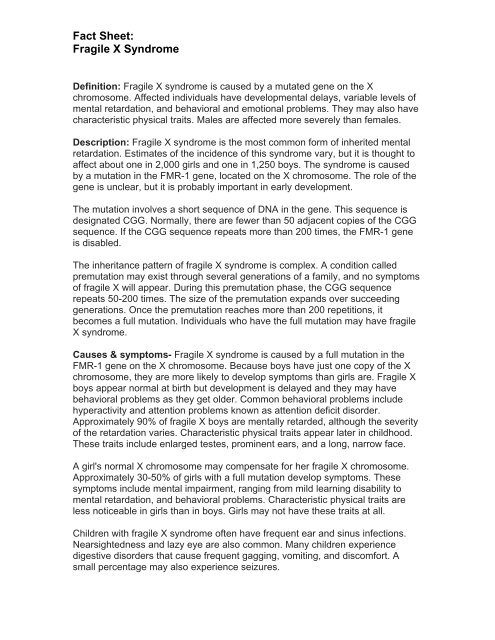Fragile X syndrome - Synergy Partners,LLC
Fragile X syndrome - Synergy Partners,LLC
Fragile X syndrome - Synergy Partners,LLC
Create successful ePaper yourself
Turn your PDF publications into a flip-book with our unique Google optimized e-Paper software.
Fact Sheet:<br />
<strong>Fragile</strong> X Syndrome<br />
Definition: <strong>Fragile</strong> X <strong>syndrome</strong> is caused by a mutated gene on the X<br />
chromosome. Affected individuals have developmental delays, variable levels of<br />
mental retardation, and behavioral and emotional problems. They may also have<br />
characteristic physical traits. Males are affected more severely than females.<br />
Description: <strong>Fragile</strong> X <strong>syndrome</strong> is the most common form of inherited mental<br />
retardation. Estimates of the incidence of this <strong>syndrome</strong> vary, but it is thought to<br />
affect about one in 2,000 girls and one in 1,250 boys. The <strong>syndrome</strong> is caused<br />
by a mutation in the FMR-1 gene, located on the X chromosome. The role of the<br />
gene is unclear, but it is probably important in early development.<br />
The mutation involves a short sequence of DNA in the gene. This sequence is<br />
designated CGG. Normally, there are fewer than 50 adjacent copies of the CGG<br />
sequence. If the CGG sequence repeats more than 200 times, the FMR-1 gene<br />
is disabled.<br />
The inheritance pattern of fragile X <strong>syndrome</strong> is complex. A condition called<br />
premutation may exist through several generations of a family, and no symptoms<br />
of fragile X will appear. During this premutation phase, the CGG sequence<br />
repeats 50-200 times. The size of the premutation expands over succeeding<br />
generations. Once the premutation reaches more than 200 repetitions, it<br />
becomes a full mutation. Individuals who have the full mutation may have fragile<br />
X <strong>syndrome</strong>.<br />
Causes & symptoms- <strong>Fragile</strong> X <strong>syndrome</strong> is caused by a full mutation in the<br />
FMR-1 gene on the X chromosome. Because boys have just one copy of the X<br />
chromosome, they are more likely to develop symptoms than girls are. <strong>Fragile</strong> X<br />
boys appear normal at birth but development is delayed and they may have<br />
behavioral problems as they get older. Common behavioral problems include<br />
hyperactivity and attention problems known as attention deficit disorder.<br />
Approximately 90% of fragile X boys are mentally retarded, although the severity<br />
of the retardation varies. Characteristic physical traits appear later in childhood.<br />
These traits include enlarged testes, prominent ears, and a long, narrow face.<br />
A girl's normal X chromosome may compensate for her fragile X chromosome.<br />
Approximately 30-50% of girls with a full mutation develop symptoms. These<br />
symptoms include mental impairment, ranging from mild learning disability to<br />
mental retardation, and behavioral problems. Characteristic physical traits are<br />
less noticeable in girls than in boys. Girls may not have these traits at all.<br />
Children with fragile X <strong>syndrome</strong> often have frequent ear and sinus infections.<br />
Nearsightedness and lazy eye are also common. Many children experience<br />
digestive disorders that cause frequent gagging, vomiting, and discomfort. A<br />
small percentage may also experience seizures.
Fact Sheet:<br />
<strong>Fragile</strong> X Syndrome<br />
Diagnosis - Behavioral and developmental problems may indicate fragile X<br />
<strong>syndrome</strong>, particularly if there is a family history of mental retardation. Definitive<br />
identification is made by means of a genetic test for the mutation. Individuals with<br />
the premutation or mutation may also be identified through genetic testing.<br />
Amniocentesis, chorionic villus sampling, and percutaneous umbilical blood<br />
sampling can be used to identify a fragile X chromosome before birth.<br />
Treatment- <strong>Fragile</strong> X <strong>syndrome</strong> cannot be cured. To reach his or her full<br />
potential, a child may require speech and language therapy, occupational<br />
therapy, and physical therapy. The expertise of psychologists, special education<br />
teachers, and genetic counselors may also be needed. Drugs are used to treat<br />
hyperactivity, seizures, and other problems. Establishing a regular routine,<br />
avoiding over stimulation, and using calming techniques can help reduce<br />
behavioral problems.<br />
Prognosis- Early diagnosis and intensive intervention offer the best prognosis<br />
for fragile X individuals. They can learn and are often good at memorizing and<br />
imitation. Most behavioral problems decrease by adulthood. About 50% of fragile<br />
X individuals develop mitral valve prolapse, a heart condition, as adults. Life span<br />
is typically normal.<br />
Prevention - Neither the permutation nor the mutation is preventable.<br />
Information from: Gale Encyclopedia of Medicine, Author: Julia Barrett


